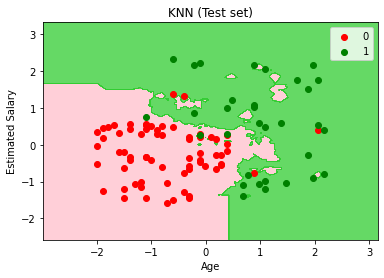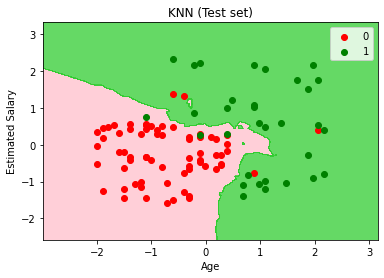机器学习—分类3-1(KNN算法)
基于KNN预测客户是否购买汽车新车型
主要步骤流程:
- 1. 导入包
- 2. 导入数据集
- 3. 数据预处理
- 3.1 检测缺失值
- 3.2 生成自变量和因变量
- 3.3 查看样本是否均衡
- 3.4 将数据拆分成训练集和测试集
- 3.5 特征缩放
- 4. 使用不同的参数构建KNN模型
- 4.1 模型1:构建KNN模型并训练模型
- 4.1.1 构建KNN模型并训练
- 4.1.2 预测测试集
- 4.1.3 生成混淆矩阵
- 4.1.4 可视化测试集的预测结果
- 4.1.5 评估模型性能
- 4.2 模型2:构建KNN模型并训练模型
- 4.1 模型1:构建KNN模型并训练模型
In [2]:
# 导入包
import numpy as np
import pandas as pd
import matplotlib.pyplot as plt
2. 导入数据集
In [3]:
# 导入数据集
dataset = pd.read_csv('Social_Network_Ads.csv')
dataset
Out[3]:
3. 数据预处理
3.1 检测缺失值
In [4]:
# 检测缺失值
null_df = dataset.isnull().sum()
null_df
Out[4]:
3.2 生成自变量和因变量
为了可视化分类效果,仅选取 Age 和 EstimatedSalary 这2个字段作为自变量
In [5]:
# 生成自变量和因变量
X = dataset.iloc[:, [2, 3]].values
X[:5, :]
Out[5]:
In [6]:
y = dataset.iloc[:, 4].values
y[:5]
Out[6]:
3.3 查看样本是否均衡
In [7]:
# 查看样本是否均衡
sample_0 = sum(dataset['Purchased']==0)
sample_1 = sum(dataset['Purchased']==1)
print('不买车的样本占总样本的%.2f' %(sample_0/(sample_0 + sample_1)))
3.4 将数据拆分成训练集和测试集
In [8]:
# 将数据拆分成训练集和测试集
from sklearn.model_selection import train_test_split
X_train, X_test, y_train, y_test = train_test_split(X, y, test_size = 0.25, random_state = 0)
print(X_train.shape)
print(X_test.shape)
print(y_train.shape)
print(y_test.shape)
3.5 特征缩放
In [9]:
# 特征缩放
from sklearn.preprocessing import StandardScaler
sc = StandardScaler()
X_train = sc.fit_transform(X_train)
X_test = sc.transform(X_test)
4. 使用不同的参数构建KNN模型
4.1 模型1:构建KNN模型并训练模型
4.1.1 构建KNN模型并训练
In [10]:
# 使用不同的参数构建KNN模型
# 模型1:构建KNN模型并训练模型(n_neighbors = 5, weights='uniform', metric = 'minkowski', p = 2)
from sklearn.neighbors import KNeighborsClassifier
classifier = KNeighborsClassifier(n_neighbors = 5, weights='uniform', metric = 'minkowski', p = 2)
classifier.fit(X_train, y_train)
Out[10]:
4.1.2 预测测试集
In [11]:
# 预测测试集
y_pred = classifier.predict(X_test)
y_pred[:5]
Out[11]:
4.1.3 生成混淆矩阵
In [12]:
# 生成混淆矩阵
from sklearn.metrics import confusion_matrix
cm = confusion_matrix(y_test, y_pred)
print(cm)
4.1.4 可视化测试集的预测结果
In [13]:
# 可视化测试集的预测结果
from matplotlib.colors import ListedColormap
plt.figure()
X_set, y_set = X_test, y_test
X1, X2 = np.meshgrid(np.arange(start = X_set[:, 0].min() - 1, stop = X_set[:, 0].max() + 1, step = 0.01),
np.arange(start = X_set[:, 1].min() - 1, stop = X_set[:, 1].max() + 1, step = 0.01))
plt.contourf(X1, X2, classifier.predict(np.array([X1.ravel(), X2.ravel()]).T).reshape(X1.shape),
alpha = 0.75, cmap = ListedColormap(('pink', 'limegreen')))
plt.xlim(X1.min(), X1.max())
plt.ylim(X2.min(), X2.max())
for i, j in enumerate([0,1]):
print(str(i)+"da"+str(j))
plt.scatter(X_set[y_set == j, 0], X_set[y_set == j,1],
color = ListedColormap(('red', 'green'))(i), label = j)
plt.title('KNN (Test set)')
plt.xlabel('Age')
plt.ylabel('Estimated Salary')
plt.legend()
plt.show()
In [14]:
X_set[y_set == 0,1]
Out[14]:
In [15]:
np.unique(y_set)
Out[15]:
4.1.5 评估模型性能
In [16]:
# 评估模型性能
from sklearn.metrics import accuracy_score
print(accuracy_score(y_test, y_pred))
In [17]:
(cm[0][0]+cm[1][1])/(cm[0][0]+cm[0][1]+cm[1][0]+cm[1][1])
Out[17]:
4.2 模型2:构建KNN模型并训练模型
In [1]:
# 模型2:构建KNN模型并训练模型(n_neighbors = 3, weights='distance', metric = 'minkowski', p = 1)
classifier = KNeighborsClassifier(n_neighbors = 100, weights='distance', metric = 'minkowski', p = 1)
classifier.fit(X_train, y_train)
In [19]:
# 预测测试集
y_pred = classifier.predict(X_test)
y_pred[:5]
Out[19]:
In [20]:
# 生成混淆矩阵
cm = confusion_matrix(y_test, y_pred)
print(cm)
In [21]:
# 可视化测试集的预测结果
plt.figure()
X_set, y_set = X_test, y_test
X1, X2 = np.meshgrid(np.arange(start = X_set[:, 0].min() - 1, stop = X_set[:, 0].max() + 1, step = 0.01),
np.arange(start = X_set[:, 1].min() - 1, stop = X_set[:, 1].max() + 1, step = 0.01))
plt.contourf(X1, X2, classifier.predict(np.array([X1.ravel(), X2.ravel()]).T).reshape(X1.shape),
alpha = 0.75, cmap = ListedColormap(('pink', 'limegreen')))
plt.xlim(X1.min(), X1.max())
plt.ylim(X2.min(), X2.max())
for i, j in enumerate(np.unique(y_set)):
plt.scatter(X_set[y_set == j, 0], X_set[y_set == j, 1],
color = ListedColormap(('red', 'green'))(i), label = j)
plt.title('KNN (Test set)')
plt.xlabel('Age')
plt.ylabel('Estimated Salary')
plt.legend()
plt.show()

In [22]:
# 评估模型性能
print(accuracy_score(y_test, y_pred))
结论:1)由上面2个模型可见,不同超参数对KNN模型的性能影响不同。






